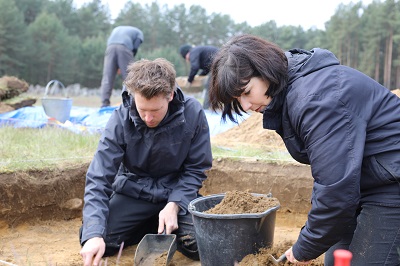Archaeologists from Staffordshire University are to lead a dig at a historical Second World War site with a dramatic link to the Holocaust.

Professor Caroline Sturdy Colls will be leading the archaeological dig.
We are absolutely delighted and honoured to be involved in this important project. The survey and excavation will hopefully provide important information about the experiences of the 300 Jewish children who arrived in Lake Windermere during the Nazi occupation of Europe.
Cumbrian-based charity Another Space, which produces and manages the Lake District Holocaust Project, has secured £48,000 from the Heritage Lottery Fund (HLF) as part of a £62,000 project to shed new light on the experience of 300 Jewish child Holocaust Survivors on their arrival in the Lake District in 1945.
The project will involve an archaeological survey and dig at the Lakes School which will be led by Staffordshire University Professor Caroline Sturdy Colls and Kevin Colls who have carried out surveys and excavations at Holocaust sites in Mainland Europe.
The Lakes School stands on the former site of the wartime workers housing scheme Calgarth Estate which was built in 1942 to house workers at the nearby Short Sunderland 'Flying Boat' factory at White Cross Bay. It was gradually demolished over time until it finally disappeared in the mid 1960s.
Each of the six hostels on Calgarth Estate housed fifty people in small, individual rooms, and each room had a bed, chest of drawers and bedroom furniture. For the child Holocaust Survivors, who had spent years in terrible conditions, these hostels were utterly luxurious.
Professor Sturdy Colls, who head up the University’s Centre of Archaeology, said: “We are absolutely delighted and honoured to be involved in this important project. The survey and excavation will hopefully provide important information about the experiences of the 300 Jewish children who arrived in Lake Windermere during the Nazi occupation of Europe. We are excited to be collaborating with the Lake District Holocaust Project as they have worked tirelessly to document the stories of the children.
“This project builds on our work at Holocaust sites and uses many of the same techniques. Crucially, this project offers us the opportunity to reveal more about British responses to the Holocaust through the physical evidence that was left behind and to examine a site which provided hope to many children during one of the darkest episodes of history.”
The survey and dig will take place during summer and autumn of 2019 and will see wide ranging opportunities for people to work closely with the leading archaeologists. It will include a cutting-edge technological survey to identify what remains of the estate lie hidden below ground. This will be followed by excavations that will focus on uncovering the remains of hostel accommodation on the estate that slept single workers from the factory.
Trevor Avery, Director of Lake District Holocaust Project says “This is an amazing opportunity for everyone to become involved in a project that is literally unique in the UK, and it is here in the Lake District. The story of Calgarth Estate in the Lake District and its connections with the flying boat factory at White Cross Bay, is fascinating. Added to that, no other location in Britain has such a strong, physical connection to the Holocaust and makes this of national importance”.
- The Lake District Holocaust Project was established in 2007 to commemorate the links between the three hundred child Holocaust Survivors who came to the Lake District in 1945, and the community that welcomed them. In 2018 alone, the story has featured in “Who Do You Think You Are?” With Robert Rinder on BBC One, “Paul Rose in the Lakes” on BBC Two, and programme dedicated the story was broadcast in “Open Country” on Radio Four.
- Calgarth Estate stood from 1942 to around 1964. It was home to two hundred families and three hundred single workers. It had a school, shops, entertainment hall, and laundry. The single storey houses were nicknamed “Shorts Palaces” by the residents and had indoor bathing and central heating facilities, still rare for working class people in the Lake District in the 1940’s. The estate was eventually demolished and Lakes School opened on the site in 1967, and most of the former residents were rehoused on the then newly built Droomer Estate in Windermere.